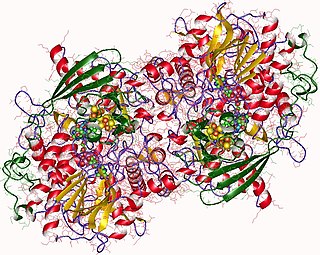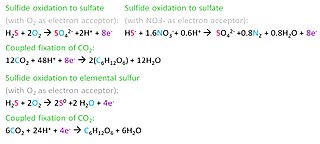Related Research Articles
The Desulfobacteraceae are a family of Thermodesulfobacteriota. They reduce sulfates to sulfides to obtain energy and are strictly anaerobic. They have a respiratory and fermentative type of metabolism. Some species are chemolithotrophic and use inorganic materials to obtain energy and use hydrogen as their electron donor.

Sulfate-reducing microorganisms (SRM) or sulfate-reducing prokaryotes (SRP) are a group composed of sulfate-reducing bacteria (SRB) and sulfate-reducing archaea (SRA), both of which can perform anaerobic respiration utilizing sulfate (SO2−
4) as terminal electron acceptor, reducing it to hydrogen sulfide (H2S). Therefore, these sulfidogenic microorganisms "breathe" sulfate rather than molecular oxygen (O2), which is the terminal electron acceptor reduced to water (H2O) in aerobic respiration.

Sulfur-reducing bacteria are microorganisms able to reduce elemental sulfur (S0) to hydrogen sulfide (H2S). These microbes use inorganic sulfur compounds as electron acceptors to sustain several activities such as respiration, conserving energy and growth, in absence of oxygen. The final product of these processes, sulfide, has a considerable influence on the chemistry of the environment and, in addition, is used as electron donor for a large variety of microbial metabolisms. Several types of bacteria and many non-methanogenic archaea can reduce sulfur. Microbial sulfur reduction was already shown in early studies, which highlighted the first proof of S0 reduction in a vibrioid bacterium from mud, with sulfur as electron acceptor and H
2 as electron donor. The first pure cultured species of sulfur-reducing bacteria, Desulfuromonas acetoxidans, was discovered in 1976 and described by Pfennig Norbert and Biebel Hanno as an anaerobic sulfur-reducing and acetate-oxidizing bacterium, not able to reduce sulfate. Only few taxa are true sulfur-reducing bacteria, using sulfur reduction as the only or main catabolic reaction. Normally, they couple this reaction with the oxidation of acetate, succinate or other organic compounds. In general, sulfate-reducing bacteria are able to use both sulfate and elemental sulfur as electron acceptors. Thanks to its abundancy and thermodynamic stability, sulfate is the most studied electron acceptor for anaerobic respiration that involves sulfur compounds. Elemental sulfur, however, is very abundant and important, especially in deep-sea hydrothermal vents, hot springs and other extreme environments, making its isolation more difficult. Some bacteria – such as Proteus, Campylobacter, Pseudomonas and Salmonella – have the ability to reduce sulfur, but can also use oxygen and other terminal electron acceptors.
In taxonomy, Methanosalsum is a genus of microbes within the family Methanosarcinaceae. This genus contains two species.

Adenylyl-sulfate reductase is an enzyme that catalyzes the chemical reaction of the reduction of adenylyl-sulfate/adenosine-5'-phosphosulfate (APS) to sulfite through the use of an electron donor cofactor. The products of the reaction are AMP and sulfite, as well as an oxidized electron donor cofactor.
Sulfur is metabolized by all organisms, from bacteria and archaea to plants and animals. Sulfur can have an oxidation state from -2 to +6 and is reduced or oxidized by a diverse range of organisms. The element is present in proteins, sulfate esters of polysaccharides, steroids, phenols, and sulfur-containing coenzymes.
Thermodesulforhabdus norvegica is a species of thermophilic sulfate-reducing bacteria, the type and only species of its genus. It is gram-negative, acetate-oxidizing, with type strain A8444.
Thiomicrospira aerophila is an obligately alkaliphilic and obligately chemolithoautotrophic sulfur-oxidizing bacterium that was previously the type species of Thioalkalimicrobium prior to reclassification in 2017. It was first isolated from soda lakes in northern Russia.
Thioalkalivibrio versutus is an obligately alkaliphilic and obligately chemolithoautotrophic sulfur-oxidizing bacteria. It was first isolated from soda lakes in northern Russia.
Desulfonatronum thiodismutans is an alkaliphilic, sulfate-reducing bacterium capable of lithoautotrophic growth. It is Gram-negative, vibrio-shaped, with cells 0.6–0.7×1.2–2.7 μm in size, motile by a single polar flagellum. Its type strain is MLF1T.
Desulfonatronum thiosulfatophilum is a species of haloalkaliphilic sulfate-reducing bacteria. It is able to grow lithotrophically by dismutation of thiosulfate and sulfite.
Desulfonatronovibrio thiodismutans is a species of haloalkaliphilic sulfate-reducing bacteria. It is able to grow lithotrophically by dismutation of thiosulfate and sulfite.

Dissimilatory sulfate reduction is a form of anaerobic respiration that uses sulfate as the terminal electron acceptor to produce hydrogen sulfide. This metabolism is found in some types of bacteria and archaea which are often termed sulfate-reducing organisms. The term "dissimilatory" is used when hydrogen sulfide is produced in an anaerobic respiration process. By contrast, the term "assimilatory" would be used in relation to the biosynthesis of organosulfur compounds, even though hydrogen sulfide may be an intermediate.
Desulfonatronobacter is a bacteria genus from the family of Desulfobacteraceae.
Desulfonatronovibrio is a Gram-negative, vibrios, anaerobic and motile genus of bacteria from the family of Desulfohalobiaceae with a single polar flagellum.
Nitriliruptor alkaliphilus is a non-spore-forming and non-motile bacterium from the genus Nitriliruptor which has been isolated from sediments from a soda lake in Siberia in Russia.
Chitinivibrio is an extremely haloalkaliphilic genus of bacteria from the family of Chitinivibrionaceae with one known species. Chitinivibrio alkaliphilus has been isolated from hypersaline lake sediments from Wadi al Natrun in Egypt.

Microbial oxidation of sulfur is the oxidation of sulfur by microorganisms to build their structural components. The oxidation of inorganic compounds is the strategy primarily used by chemolithotrophic microorganisms to obtain energy to survive, grow and reproduce. Some inorganic forms of reduced sulfur, mainly sulfide (H2S/HS−) and elemental sulfur (S0), can be oxidized by chemolithotrophic sulfur-oxidizing prokaryotes, usually coupled to the reduction of oxygen (O2) or nitrate (NO3−). Anaerobic sulfur oxidizers include photolithoautotrophs that obtain their energy from sunlight, hydrogen from sulfide, and carbon from carbon dioxide (CO2).
Methylohalomonas is a moderately halophilic and obligately methylotrophic genus of purple sulfur bacteria with one known species. Methylohalomonas lacus has been isolated from hypersaline lakes from the Kulunda Steppe in Russia.
Dissimilatory sulfite reductase is an enzyme that participates in sulfur metabolism in dissimilatory sulfate reduction.
References
- ↑ Sorokin, D. Y.; Tourova, T. P.; Kolganova, T. V.; Detkova, E. N.; Galinski, E. A.; Muyzer, G. (2011). "Culturable diversity of lithotrophic haloalkaliphilic sulfate-reducing bacteria in soda lakes and the description of Desulfonatronum thioautotrophicum sp. nov., Desulfonatronum thiosulfatophilum sp. nov., Desulfonatronovibrio thiodismutans sp. nov., and Desulfonatronovibrio magnus sp. nov". Extremophiles. 15 (3): 391–401. doi: 10.1007/s00792-011-0370-7 . ISSN 1431-0651. PMC 3084936 . PMID 21479878.